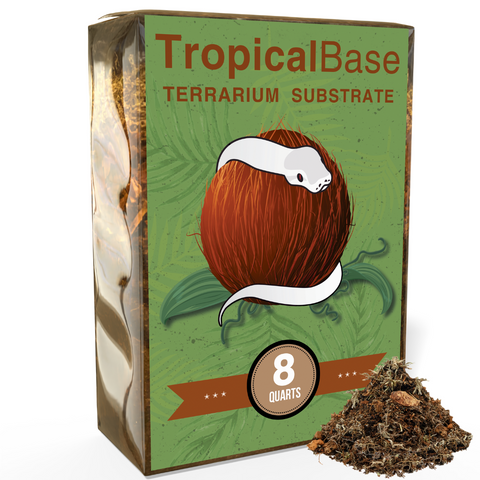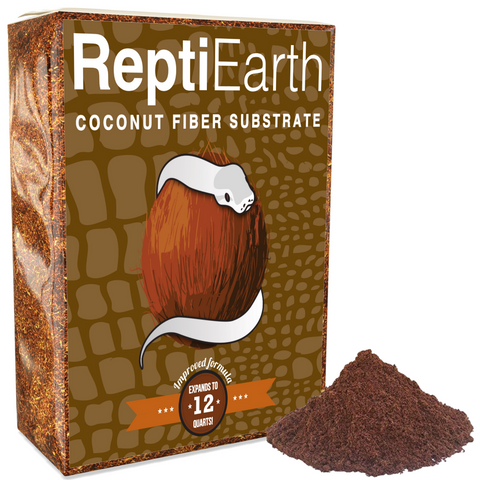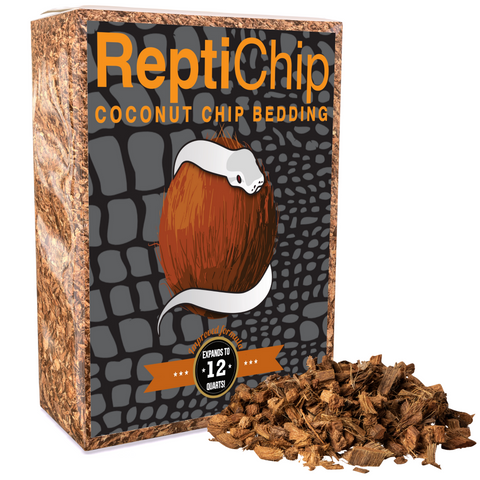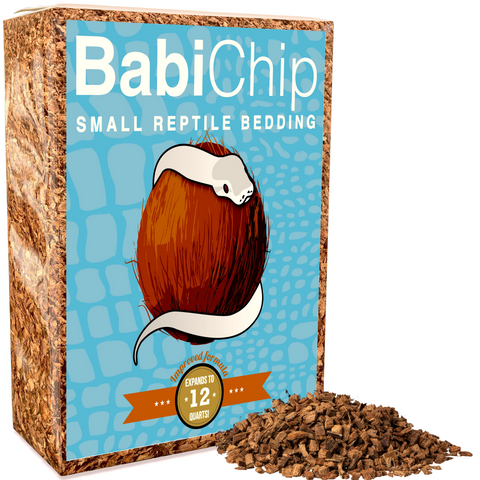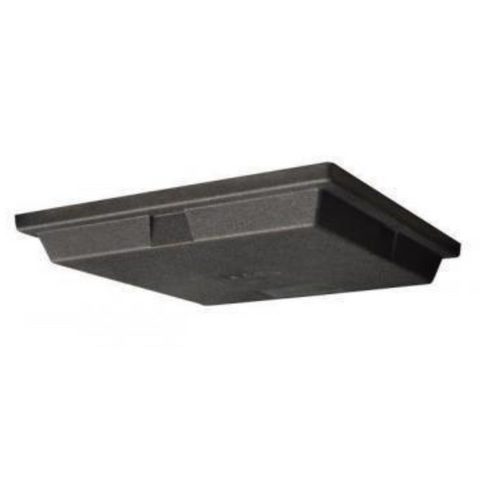Natural History
Henkel's leaf-tailed gecko is a distinctive arboreal reptile native to the humid tropical forests of Madagascar, particularly within the island’s northern regions. Its life cycle begins with small eggs laid by the female, typically in a secure, concealed location such as under loose bark or within dense vegetation. Clutches usually consist of two eggs, and females may produce multiple clutches per breeding season, depending on environmental conditions and nutrition. The incubation period varies between 70 to 120 days, heavily influenced by ambient temperature and humidity levels. Hatchlings emerge measuring just under 3 inches in total length and are fully independent from birth. They experience gradual growth over the first few years, reaching sexual maturity at approximately 24 months. Adults typically measure 8 to 11 inches long, including the tail. In the wild, their average lifespan is around 8 to 10 years, though individuals have been known to live longer under optimal conditions in captivity.
In terms of behavior, Henkel’s leaf-tailed gecko is primarily nocturnal, remaining hidden during the day using its near-flawless camouflage to blend into lichen-covered bark and leaf litter. This camouflage is a crucial defense strategy, supported further by its flat body and tail that mimic the appearance of dead leaves. When threatened, they may flatten their bodies even more, gape, or drop their tails as a distraction—a process known as caudal autotomy. During active nighttime hours, they emerge to hunt, primarily feeding on a variety of insects and other arthropods. Their hunting technique is characterized by slow, stealthy movements combined with rapid lunges to capture prey with a sudden snap of the jaws. Unlike some geckos, Henkel’s leaf-tailed geckos are generally solitary and mildly territorial. Males may show aggression toward one another if housed in close proximity or during the mating season, when competition increases. During breeding periods, males may exhibit courtship behaviors that include body licking and tail waving.
Ecologically, Henkel’s leaf-tailed gecko serves an essential role as a mid-level predator within its forest ecosystem. By preying on insects, spiders, and occasionally smaller vertebrates, they help regulate invertebrate populations, contributing to natural pest control. In turn, they are prey for larger snakes, birds, and some small mammalian carnivores. Their cryptic appearance and arboreal habits have evolved to maximize evasion from such predators, with specialized toe pads and prehensile tails that facilitate movement through tree canopies with precision and stability. Additionally, their sensitivity to environmental changes—particularly deforestation and habitat degradation—positions them as important bioindicators of forest health. Their presence within a region often suggests a relatively intact and functioning ecosystem.
Adapted to a complex and competitive arboreal environment, Henkel’s leaf-tailed gecko displays advanced survival strategies, including highly specialized camouflage, night vision, and climbing adaptations. These features not only define its niche within Madagascar’s rainforests but also underscore the importance of habitat conservation. For prospective keepers, understanding these wild behaviors and ecological relationships is crucial to providing a captive environment that supports natural instincts, physiological needs, and overall well-being.
Conservation Status
According to the International Union for Conservation of Nature (IUCN) Red List, the Henkel's leaf-tailed gecko is currently classified as Vulnerable. This status indicates that the species is facing a high risk of extinction in the wild due to rapid population declines and restricted range. Although it maintains populations in specific locations, primarily on the island of Madagascar, its distribution is fragmented and limited mainly to northern Madagascar’s remaining primary forests. A Vulnerable classification means that if current environmental pressures are not mitigated, the species is likely to move toward Endangered status in the foreseeable future. The population trend is decreasing, which reflects ongoing habitat degradation and other anthropogenic threats that impact species health and recovery prospects.
The most pressing threat facing the Henkel's leaf-tailed gecko is habitat loss due to deforestation. Madagascar's forests are being cleared at an alarming rate, largely for slash-and-burn agriculture, charcoal production, and illegal logging activities. This species relies on intact, humid forest ecosystems with high humidity, stable temperatures, and abundant arboreal cover. As these forests are disrupted, individuals lose access to crucial microhabitats essential for thermoregulation, camouflage, foraging, and reproduction. Climate change poses an additional risk by altering temperature and precipitation patterns, potentially reducing the gecko’s suitable habitat further. Another critical threat is illegal collection for the international pet trade. While captive-bred individuals are available, many wild specimens have been taken unlawfully, especially during the 1990s and early 2000s, which significantly reduced some local populations. The species’ highly specialized biology and low reproductive rate reduce its ability to rebound quickly from such pressures.
To mitigate these threats, several conservation efforts are underway. The Henkel's leaf-tailed gecko is listed on Appendix II of CITES (the Convention on International Trade in Endangered Species of Wild Fauna and Flora), which means that international export is regulated to ensure it does not threaten wild populations. In Madagascar, the species receives some level of protection under national laws that prohibit the collection and export of wild individuals without appropriate permits; however, enforcement can be inconsistent. Protected areas such as Lokobe National Park and the Ankarana Special Reserve harbor viable populations of the gecko, maintaining essential forest habitat under some level of formal protection. While these reserves provide a refuge for the species, the continued loss of unprotected forest fragments still poses an existential threat to isolated populations.
Captive breeding programs have also played a valuable role. Several institutions and private breeders have established ex-situ populations of Henkel's leaf-tailed geckos, which aid in preserving genetic diversity and reducing pressure on wild populations. Although large-scale reintroduction efforts have not yet been implemented, captive-bred individuals may serve as a genetic reservoir if wild populations decline critically. Efforts to educate reptile enthusiasts on the importance of sourcing only legally bred geckos further support conservation goals. In addition, community-based conservation projects promoting forest preservation and sustainable land use practices among local Malagasy populations help address the root causes of habitat loss. Long-term survival of the Henkel's leaf-tailed gecko depends on continued habitat protection, enforcement of wildlife trade regulations, support for captive breeding, and sustained international cooperation for conservation.
Native Range
Henkel’s leaf-tailed gecko is native to the island of Madagascar, specifically restricted to the humid, tropical forests of the island’s northern region. Its distribution is limited to the Nosy Bé archipelago and select nearby areas on the northern Malagasy mainland, including parts of the Lokobe Reserve and adjacent forested habitats. This species exhibits a relatively restricted range, occurring only in these fragmented zones characterized by intact primary or very mature secondary forest. Due to its narrow distribution, the gecko is considered endemic to this part of Madagascar, making it particularly susceptible to habitat loss and ecological disturbance.
The macrohabitat of this gecko is dense, lowland tropical rainforest. These forests are known for their high biodiversity, closed canopies, and high year-round humidity. Within this broad environment, Henkel’s leaf-tailed gecko occupies very specific microhabitats. It is a strictly arboreal species, usually found clinging to the trunks and branches of mature trees. The gecko prefers vertical surfaces, particularly those with textured bark that facilitates camouflage. It is often seen resting on tree trunks during the day, aligned vertically along the bark to maximize its cryptic appearance, and becomes more active at night when it forages and moves more freely among the canopy and mid-story. This species is not typically found on the forest floor and avoids open or heavily disturbed areas, highlighting its reliance on structurally complex, undisturbed forest habitats.
Climatically, Henkel’s leaf-tailed gecko is adapted to a warm and humid tropical environment. Average daytime temperatures in its native habitat range from 75°F to 82°F, with nighttime temperatures cooling slightly to 65°F to 74°F. Relative humidity levels remain consistently high throughout the year, typically between 70% and 90%. Rainfall is abundant, especially during the wet season, which extends from November through April. During this period, precipitation is frequent, occurring almost daily, and totals often exceed 80 inches annually. The dry season, from May to October, sees a reduction in rainfall, though humidity levels often remain elevated due to canopy cover and residual moisture. These seasonal shifts influence the behavior of Henkel’s leaf-tailed gecko, particularly in terms of activity patterns, foraging behavior, and possibly reproductive timing.
In terms of elevation, this species is found primarily in lowland environments, typically between 100 and 1,300 feet above sea level. It is rarely found at higher elevations, as it depends on the specific structural and climatic conditions of coastal and low-elevation rainforest ecosystems. Key environmental elements critical to this species’ survival include access to tall trees with rough, furrowed bark, which not only aid in camouflage but also provide hunting grounds for insect prey. The presence of dense canopy cover is vital for regulating microclimate stability, maintaining high humidity, and providing shade. Additionally, the gecko requires a stable moisture regime to support skin health and hydration, as well as essential prey availability such as insects and other arthropods. Microhabitats rich in epiphytic growth, moss, and lichen are also favorable, as they contribute both to the species’ camouflage and to humidity retention in the area.
In summary, Henkel’s leaf-tailed gecko is a highly specialized forest-dwelling reptile with strict habitat requirements. Its survival is closely tied to the undisturbed rainforest ecosystems of northern Madagascar, where stable temperatures, high humidity, a dense vertical canopy structure, and textured vegetation are essential components of its ecological niche. Habitat degradation, deforestation, and fragmentation thus pose significant threats to its continued existence in the wild.
Behavior
Henkel's leaf-tailed gecko is a nocturnal arboreal lizard, exhibiting the peak of its activity after sunset. In its native environment—humid forests of northern Madagascar—this species spends daylight hours motionless and camouflaged against tree bark, relying on its flattened body and cryptic patterning for concealment. Once night falls, the gecko becomes active, engaging in foraging and territorial behaviors. Seasonal changes influence activity levels; during cooler months, geckos reduce movement and feeding, likely entering a mild form of brumation if nighttime temperatures consistently drop. During the wet season, which aligns with their breeding period, individuals show increased activity and interaction, particularly related to courtship and mating behaviors.
In terms of social structure, Henkel's leaf-tailed geckos are solitary and strongly territorial. In the wild, they maintain isolated home ranges, with males typically occupying larger and more aggressively defended areas than females. When two males encounter each other, aggressive displays such as body inflation, open-mouth posturing, and tail waving may occur. Physical confrontations can happen when territory boundaries are challenged, though these are usually short-lived. During the breeding season, males may range more widely in search of receptive females. Courtship involves tactile signaling and gentle biting, often culminating in copulation without prolonged pair bonding. Females lay small clutches, usually one or two eggs, in protected niches such as bark crevices or leaf litter. Unlike some other gecko species, there is no parental care after oviposition.
This species is highly sensitive to environmental stimuli. It relies on photoperiod and temperature cues to regulate its circadian rhythms and seasonal behaviors. Sudden drops in temperature cause it to become lethargic, while prolonged exposure to temperatures above 80°F may result in stress, hyperactivity, or dehydration. Humidity fluctuations are particularly impactful; if ambient humidity falls below 60%, the gecko may show difficulty shedding or reduced feeding response. In areas with consistent lighting cycles, behavior becomes more predictable, with emergence from hiding places occurring shortly after lights-off in captive settings. Henkel's leaf-tailed gecko uses its keen vision to detect prey and relies primarily on movement cues to initiate feeding responses. It also detects chemical cues through its Jacobson’s organ, helping it track conspecifics and potential mates.
Predator avoidance relies heavily on camouflage. Its bark-mimicking coloration and leaf-shaped tail make it nearly indistinguishable from its surroundings when immobile. If threatened, it may employ a series of defensive strategies, including body flattening, mouth-gaping, and tail-undulating behaviors that serve to mislead attackers. Unlike some geckos, it does not autotomize (drop) its tail readily, as the tail serves both as camouflage and a critical balancing structure during climbing. Thermoregulation is accomplished behaviorally—by shifting locations vertically within the canopy to access warmer or cooler microclimates. Though ectothermic, it avoids basking in direct sunlight, instead relying on ambient warmth and retained heat within tree trunks and foliage.
In captivity, behavioral expression is altered in several notable ways. Though still nocturnal, captive individuals often adapt their activity patterns to artificial light cycles. They may become active shortly after enclosure lights are turned off and remain so for several hours. Without the need to search for food or defend territory, captive geckos may exhibit reduced roaming and lower interaction rates. Feeding in captivity is typically more regular, and prey capture is often less vigorous, especially if live insect prey is repeatedly presented in the same predictable manner. Providing climbing structures, visual barriers, and feeding variety can help maintain natural foraging and hunting behaviors. Stress responses can occur due to overhandling, inadequate hides, or improper humidity; these may be expressed as refusal to feed, increased hiding, or sudden bursts of escape behavior.
Henkel's leaf-tailed gecko shows individuality through its unique locomotion—a slow, deliberate gait that minimizes visual detection, and a tendency to freeze rather than flee when confronted. Its mastery of camouflage and specialized toe pads allow it to cling to smooth vertical surfaces, while its flat body facilitates movement through narrow crevices and dense foliage. In managed environments, encouraging exploration through enrichment and environmental complexity can support these natural behaviors and reduce the risk of behavioral atrophy.
Captivity Requirements
Enclosure Design
The Henkel's leaf-tailed gecko is a highly arboreal and nocturnal lizard native to the montane rainforests of Madagascar. In captivity, their enclosure must replicate the vertical structure and humidity-retentive nature of this environment. For a single juvenile, a minimum enclosure size of 12 inches long by 12 inches wide by 18 inches high is acceptable. However, as they mature, adults require a vertical enclosure with a minimum footprint of 18 inches long by 18 inches wide by 36 inches high. When housing multiple geckos, particularly a breeding pair, the enclosure should be expanded accordingly, and visual barriers should be added to reduce territorial stress.
Enclosures made from PVC, sealed plywood, or glass with ample ventilation through mesh panels are ideal. Screen enclosures are not recommended as they fail to retain humidity and heat effectively. Front-opening enclosures with secure locking mechanisms are the best option, offering ease of access without allowing escape. These geckos are strong climbers and can flatten their bodies to squeeze through narrow gaps, so all doors, ventilation panels, and cable entry points must be tightly sealed or covered with fine metal mesh.
The interior must mimic their natural forest habitat. Vertical and horizontal climbing structures should dominate the space, including cork bark tubes, naturalistic branches, and securely fixed vertical logs. Foliage—either live or artificial—should be dense enough to provide cover while allowing for airflow. Hides should be placed both high and low to accommodate the gecko’s preference for seclusion at different temperatures and humidity levels. A basking spot should be placed near the upper third of the enclosure but not too exposed, as these geckos prefer dappled light and moderate warmth.
Lighting and Heating
Although primarily nocturnal, Henkel's leaf-tailed geckos benefit significantly from exposure to UVB radiation. A 5-7% UVB bulb is adequate, positioned 10 to 12 inches from the basking zone, mounted on the outside of a mesh screen or within a fixture with a reflector that directs light downward. UVB exposure should be no more than 10-12 hours per day, mimicking the natural day-night cycle. For effective synthesis of vitamin D3 and proper calcium metabolism, it is critical the UVB bulb is replaced every 6 to 12 months, depending on the brand and type, even if it appears to illuminate normally.
Temperature gradients must be carefully maintained using thermostatically controlled heating elements. The basking area should reach 80 to 82°F, while the ambient temperature during the day should remain between 72 and 78°F. At night, temperatures can safely drop to between 65 and 72°F, emulating the cooling of the montane rainforest nights. Infrared bulbs should not be used at night as they may disrupt natural behaviors. Instead, a ceramic heat emitter or radiant heat panel controlled by a reliable thermostat is the safest and most effective option if additional heating is required during cooler seasons or in temperature-variable homes.
Seasonal photoperiods should be adjusted to simulate natural changes in light duration. In summer months, a photoperiod of 12 to 13 hours is appropriate, while in winter it can be reduced to 10 to 11 hours. These changes can assist with breeding cycles and hormonal regulation. Avoid placing the enclosure in areas receiving inconsistent lighting or drafts that could impact temperature stability or disturb their light-sensitive routines.
Substrate and Enrichment
Henkel’s leaf-tailed geckos thrive in a substrate that supports moderate to high humidity, allows for microfauna growth, and minimizes impaction risks. A layered substrate is ideal, with a drainage layer at the base (such as expanded clay balls or a false bottom), a mesh separator, and a main substrate layer composed of ReptiChip or a custom mix using ReptiChip blended with leaf litter and ReptiEarth. This combination retains humidity while allowing for naturalistic digging and safer interactions with the ground layer. A premade mix such as TropicalBase is also a great option, particularly for Bioactive enclosures.
Enclosure enrichment must cater to the species’ climbing and hiding instincts. Vertical space should be fully utilized with cork rounds, manzanita branches, and natural hardwood gutted trunks, allowing them to cling, rest, and patrol territory. Place at least two to three hides within the enclosure—one near the basking area and another near the cooler, more humid region. Dense foliage provides security and simulates the camouflage opportunities these geckos rely on in the wild. Low-lying cover, like broad-leafed plants and leaf litter layers, is also beneficial, especially when females are cycling or gravid.
Interactive features such as feeding ledges, magnetic hides, and natural bark wall tiles encourage exploration and help reduce enclosure boredom. Although they are not as overtly active as some species, Henkel’s geckos engage in territorial patrols, hunting activity, and vertical movement—behavioral complexity that should be supported by a richly furnished and dynamic habitat.
Humidity and Hydration
Maintaining correct humidity is vital for Henkel’s leaf-tailed geckos due to their native rainforest origins. Optimal relative humidity should range between 70% and 85%, with diurnal fluctuations that momentarily drop humidity to around 60% during the day, followed by nighttime increases. This pattern mirrors natural ecological rhythms and promotes healthy shedding, hydration, and respiratory function.
Achieving these humidity levels requires a combination of strategies. Daily manual misting, best done in the evening, is essential and should be applied generously to the enclosure walls, foliage, and vertical surfaces, allowing the geckos to lap droplets—a behavior they use more commonly than drinking from standing water. Incorporate a secondary light misting in the morning when necessary, especially in drier climates or seasons. In setups that require automated solutions, cool mist ultrasonic foggers can be utilized, ideally on a nighttime timer to simulate increasing nocturnal humidity.
Use of a high-quality humidity-retaining substrate, such as ReptiChip or a mix of ReptiChip and ReptiEarth, supports ambient levels while also accommodating microclimatic zones. Additionally a premade mix such as TropicalBase is a great option, particularly for Bioactive cages. Adding live plants like pothos, philodendron, or bromeliads improves hydration through leaf condensation and transpiration while aesthetically enhancing the enclosure. Ventilation must be balanced to prevent stagnant conditions which could promote fungal growth or respiratory infections.
Hydration should also be supplemented with a shallow water dish placed on a raised ledge or among the vegetation. While some individuals may not directly drink from dishes, it remains a good backup option. Accurate digital hygrometers should be used—preferably one near the lower third of the enclosure and another near the upper zone—to ensure consistent monitoring of environmental humidity. Regular calibration of gauges and visual assessment of skin condition and shedding helps confirm hydration adequacy.
Diet & Supplementation
Henkel's leaf-tailed gecko is an insectivorous species native to the montane rainforest environments of northwestern Madagascar. In its natural habitat, this gecko primarily feeds on a wide range of invertebrate prey, including orthopterans (such as crickets and katydids), beetles, moths, caterpillars, spiders, and occasionally smaller soft-bodied insects like flies. As a nocturnal arboreal predator, it conducts most of its feeding activity at night when its prey is most active. The species has highly adapted camouflage and a flattened body that allows it to remain motionless and undetected on tree trunks or branches, employing a sit-and-wait, or ambush, predation strategy. It uses visual prey detection to locate and track movement, with its large, forward-facing eyes optimized for low-light hunting. Once within striking distance, it lunges with precision, gripping prey with its strong jaws before swallowing it whole.
This gecko does not use venom or constriction; instead, its hunting relies on speed, stealth, and precision. Though capable of short bursts of locomotion, it prefers to remain motionless until prey comes close enough to capture. Chemoreception also plays a minor role, with tongue-flicking behaviors used occasionally for chemical sampling of the environment. Sensory adaptations like vertical pupils and excellent night vision allow the gecko to detect even subtle movements in dimly lit forest understories.
Juvenile Henkel's leaf-tailed geckos exhibit similar predatory behavior but feed on proportionally smaller prey such as fruit flies, pinhead crickets, and small roaches. They require more frequent feeding due to their higher metabolic rate during growth. As the gecko matures, the size and variety of acceptable prey increase, with adults able to take larger insects, including full-sized crickets and certain cockroach species. Seasonal changes in the wild may influence prey availability; during cooler or drier months, the gecko may reduce its activity and feeding frequency accordingly. In the captive environment, replicating this natural variability in feeding can promote health and simulate conditions that align with circannual biological rhythms.
In captivity, the species remains strictly insectivorous. A nutritionally complete diet should include a variety of appropriately sized feeder insects such as gut-loaded crickets, black soldier fly larvae, dubia roaches, waxworms (as occasional treats due to high fat content), and silkworms. Prey insects should be gut-loaded for 24 to 48 hours prior to feeding, using a nutrient-dense commercial or homemade mix rich in carotenoids, calcium, and vitamins. Additionally, prey should be lightly dusted with a phosphorus-free calcium powder at least two to three times weekly for adults and more frequently—up to five times weekly—for juveniles. A multivitamin containing vitamin D3 should be used no more than once every 7 to 10 days, depending on exposure to artificial UVB lighting or natural sunlight, to avoid hypervitaminosis.
Captive feeding challenges may include dietary monotony leading to nutrient imbalances, overfeeding resulting in obesity, and underfeeding or nutrient deficiency causing metabolic bone disease or lethargy. Food refusal is occasionally observed and may be linked to improper enclosure temperatures (below 72°F at night or above 85°F during the day), stress, illness, or breeding cycles. Offering feeding opportunities in the evening replicates natural behavior and increases feeding response. Environmental enrichment can stimulate feeding behavior: placing insects in different parts of the enclosure, using live-feeding stations, or employing tongs for gentle movement can encourage the gecko’s predatory instincts. Avoid feeding high-fat prey items frequently, and remove uneaten insects within 24 hours to prevent stress or injury to the gecko, especially from crickets, which can bite.
Overall, Henkel’s leaf-tailed gecko thrives on a captive diet that mimics its natural feeding habits, emphasizing prey variety, proper gut loading, and consistent supplementation. Awareness of its nocturnal hunting patterns, life stage-specific dietary needs, and seasonal feeding cues can significantly enhance success in long-term husbandry and promote a healthy feeding routine.
Reproduction
Henkel's leaf-tailed geckos are a visually striking arboreal species endemic to the forests of Madagascar. Captive breeding of this species requires a precise understanding of their natural behaviors, reproductive biology, and environmental triggers. These lizards exhibit moderate sexual dimorphism; males typically have a broader tail base due to the presence of hemipenes, while females tend to be slightly larger overall with a more robust body build. Males also possess preanal pores, which are absent or less developed in females. Sexual maturity is reached at approximately 24 months of age under optimal captive conditions, though growth rate may vary based on diet and environmental quality.
Courtship behaviors involve a series of tactile and visual signals. A receptive female will tolerate the approach of a male, who typically initiates courtship with deliberate head bobbing and body posturing. Males may nudge or gently bite the female in a consistent and patterned manner, which serves both to verify receptivity and to position themselves for copulation. Vocalizations are not commonly observed in this species during courtship. It is important to monitor these interactions closely, as unreceptive females may respond aggressively, leading to stress or injury. For this reason, pairing should occur under supervision, and the geckos should be separated if aggression escalates beyond the initial interaction.
Environmental cycling is critical to stimulate breeding behavior. In their natural habitat, Henkel's leaf-tailed geckos experience a distinct seasonal pattern, including a cooler and drier winter and a warmer, more humid summer. To replicate this in captivity, breeders should implement a seasonal cycle with temperature and humidity variations. From approximately November through March, day temperatures should be maintained between 74–80°F, with a nighttime drop to 65–70°F. During this cooler period, relative humidity should be lowered to about 50–60%, simulating the dry season. Starting in April, the environment can be gradually returned to a warmer and more humid pattern—daytime temperatures of 78–84°F, nighttime lows around 70°F, and humidity levels increased to 70–80%. Additionally, photoperiod should be adjusted from 10 hours of daylight in winter to up to 14 hours during the summer cycle.
Henkel's leaf-tailed geckos are oviparous, laying eggs rather than giving live birth. Females require suitable nesting sites within the enclosure to deposit their eggs. In captivity, they often choose a secluded horizontal surface such as a cork bark slab, crevice, or shallow container partially filled with damp sphagnum moss. Providing multiple nesting options increases the likelihood of successful oviposition. Because this species is primarily solitary, it is advisable to pair males and females only during breeding attempts. Long-term cohabitation can lead to stress, competition, and injuries. A dedicated breeding enclosure mimicking their natural environment, complete with vertical climbing surfaces, dense foliage, and hiding spots, is often ideal for facilitating reproductive interactions while minimizing territorial stress.
Captive breeding challenges include incompatibility between potential mates, which can result in aggressive encounters or failure to copulate. To mitigate this, geckos should be introduced gradually, perhaps with a visual barrier initially so they can acclimate to each other's presence. Additionally, stress from suboptimal environmental conditions—such as inadequate humidity, incorrect temperature cycling, or poor enclosure design—often leads to reproductive inactivity. Careful monitoring and adjustment of husbandry parameters are essential. Poor nutrition is another limiting factor; breeding animals should receive a calcium-rich diet, with gut-loaded insects and appropriate supplementation to support reproductive health. Ensuring that females are in peak physical condition is necessary to avoid egg-binding or incomplete oviposition.
By carefully replicating their natural seasonal cues and controlling for social and environmental variables, successful captive breeding of Henkel’s leaf-tailed geckos is achievable. However, it requires detailed attention to husbandry and a solid understanding of their reproductive ecology.
Incubation & Neonate Care
Henkel's leaf-tailed geckos are an oviparous species, meaning they reproduce by laying eggs rather than giving live birth. Females typically lay clutches of two eggs, and multiple clutches can be produced during the breeding season, which commonly corresponds with warmer, wetter months in their native habitat. Once deposited, the eggs are usually adhered to a secure surface such as bark, leaf litter, or among crevices in their arboreal environment. In captivity, females will often select an elevated, secluded area within the enclosure if provided, such as behind cork bark or within a vertically mounted laying box.
The incubation process is a critical phase requiring precise environmental control to ensure embryo development and a successful hatch. Eggs should be removed carefully from the enclosure if desired and transferred to an artificial incubator setup, although they can be incubated in situ if conditions are ideal. The optimal incubation temperature for Henkel’s leaf-tailed gecko is between 72°F and 78°F. Humidity levels in the incubation container should be maintained between 70% and 85%, avoiding excessive moisture which can cause mold or drown embryos. An appropriate incubation medium includes a damp mixture of vermiculite or perlite, mixed with water at a 1:1 weight ratio. The eggs are semi-permeable and require steady airflow and humidity balance to support embryonic respiration.
Temperature-dependent sex determination has not been conclusively documented in this species, and current breeding practices do not rely on manipulating temperature to influence the sex ratio. However, fluctuations outside the optimal range can increase the likelihood of developmental abnormalities or failed hatching. The incubation period for Henkel’s leaf-tailed geckos averages 70 to 120 days but can vary depending on temperature and humidity consistency.
Hatching is typically a low-intervention process. As development nears completion, the neonate uses an egg tooth to slit the egg and gradually emerges over several hours. Once hatched, neonates are vulnerable and should be left in the incubation container until they absorb their yolk sac and begin to move independently. If incubated in the main enclosure, care must be taken to shield the young geckos from adult inhabitants. Adult geckos may ignore the hatchlings, but there is a risk of stress or predation, so it is best to separate neonates into their own enclosures soon after emergence.
Neonate care must prioritize environmental stability and stress minimization. Individual enclosures are recommended to monitor feeding and health, approximately 12 inches tall with vertical climbing options and leaf cover. Enclosure temperatures should mimic adult ambient ranges: a daytime gradient of 72°F to 78°F with a nighttime drop to 65°F to 70°F. A basking area is not necessary but can be provided at around 80°F. Relative humidity must remain between 70% and 80%, with daily misting to encourage drinking and maintain moisture necessary for skin shedding.
The first shed typically occurs within the first week after hatching, and feeding should be offered shortly afterward. Appropriate first meals include pinhead crickets, flightless fruit flies, and other small invertebrates appropriately dusted with calcium and vitamin D3. Feeding should occur every other day, with uneaten prey removed promptly to avoid stress or injury. Neonates are prone to dehydration and incomplete sheds, so maintaining proper humidity and providing access to water droplets on leaves and enclosure surfaces is essential.
Neonates should only be handled when necessary, as excessive contact can lead to stress and potential tail dropping—a common defensive behavior in leaf-tailed geckos. When handling is required for enclosure cleaning or health inspections, care should be taken to support the animal fully and maintain a calm, secure grip. Close observation of growth, behavior, and appetite will help detect any early signs of illness, such as impaction or metabolic bone disease, which are more easily prevented than treated. With appropriate husbandry, neonates develop steadily and may reach sub-adult size within 8 to 10 months, at which point they can transition to larger, enriched enclosures.
Conclusion
Henkel’s leaf-tailed gecko represents a remarkable example of evolutionary specialization, perfectly adapted to Madagascar’s dense, humid rainforest ecosystems. Its reliance on complex environmental cues, from high humidity and stable temperatures to textured arboreal surfaces, underscores the importance of habitat fidelity both in the wild and in captivity. Successfully keeping this species requires mimicking these natural conditions with precision, from enclosure design and climate regulation to feeding strategies and breeding management. A failure to do so can rapidly result in health decline, as this gecko is particularly sensitive to improper humidity, temperature instability, and enclosure stressors such as overcrowding or insufficient cover.
In captivity, Henkel’s leaf-tailed gecko thrives when provided with an environment that prioritizes verticality, environmental complexity, seasonal cycling, and strict nocturnal rhythms. These foundational husbandry elements enable not only its physical well-being but also the expression of natural behaviors that promote psychological health—such as ambush hunting, cryptic camouflage, and territorial patrolling. For those seeking to breed this species, attention to reproductive ecology—including seasonal variation, dietary fortification, and courtship dynamics—is essential for successful pairing, egg development, and hatchling viability.
However, the care of Henkel’s leaf-tailed gecko extends beyond husbandry alone. This is a species still facing considerable challenges in the wild, including habitat destruction and illegal collection. The continued availability of this species in captivity depends heavily on ethical sourcing from captive-bred specimens and participation in responsible breeding programs. Captive populations serve as important reservoirs not just for enthusiasts but potentially for conservation efforts in the future.
Informed keepers play a critical role in this gecko's future by committing to high standards of care, contributing to sustainable captive populations, and supporting conservation efforts aimed at preserving Madagascar’s shrinking rainforest ecosystems. By appreciating the unique biology and environmental sensitivity of Henkel’s leaf-tailed gecko, keepers can ensure that their individual animals not only survive, but thrive—while promoting a broader understanding of and respect for one of Madagascar’s most iconic reptilian inhabitants.



